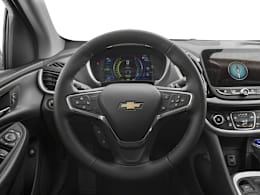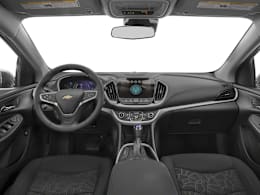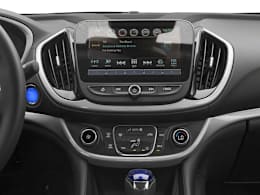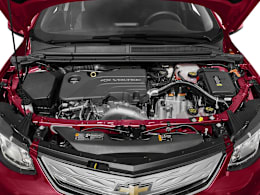Ever since it appeared on the electric car scene in 2011, the Chevy Volt brought a measure of practicality and peace of mind with its supplemental gas engine that would kick in to extend the Volt's limited battery-only range. Now, redesigned for 2016, the Volt returns as a more mature and capable car. It replaces the original Volt's science experiment ambience with more conventional looks and expanded capability, most notably a commuter-friendly electric range of 50 miles.
Pricing starts at over $34,000 for the LT and goes to around $38,000 for the Premier version. That's about a $6,000 price drop compared to the original Volt we tested in 2011. Plus, the Volt still benefits from the $7,500 federal tax incentive available to electric car buyers. That means that the effective purchase price ends up being very close to a Toyota Prius.
On the topic of cost, with current gas prices -- which sit in the low $2.00 per gallon range -- there is nearly no real cost benefit to driving the Volt over a Toyota Prius, which gets 52 mpg overall. The only time the Volt makes more fiscal sense than the Prius is if you pay less than 13 cents per kWh of electricity to recharge the battery, and rarely use the Volt's gas engine.
When the Volt's battery is full, it operates just like an electric car for about 50 miles -- covering most typical commutes on a single charge. Once the battery level drops to a low level, the car makes a commendably smooth transition to gas mode (charge sustaining). In that mode, the car operates pretty much as a traditional hybrid with sufficient electric power for low-speed driving, typically up to 25 mph. In that mode alone we measured 38 mpg.
With the Volt's small 8.9-gallon fuel tank, that translates to additional 340 miles range, on top of its electric-only portion, for a total range of 390 miles. That eliminates range anxiety typical of nearly all electric vehicles. Driving purely on electric power, the Volt consumed 3.1 miles/kWh which is the equivalent of 105 MPGe. A full charge takes about 16 kWh, which on a national average electricity price of 12 cents costs less than $2.00.
Regardless of mode, the Volt benefits from a robust and smooth power delivery thanks to the electric motor's wallop of torque. We clocked acceleration at 8 seconds from 0-60 mph.
With our 240-volt connector, we observed a charging time of 4.5 hours. A portable home kit allows for charging on regular household 120-volt line, but that takes an impractical 18 hours on the default setting or 13 hours on a quicker setting. That's a long time, but it still shows that an overnight charge is feasible without having to invest in a dedicated home charger.
Ride comfort and noise isolation are commendable in the Volt. The suspension irons out just about any bumpy pavement, lending the car a solid and mature feel. Overall, the Volt feels a lot more substantial than the Prius, its natural rival in the green arena.
Handling is initially responsive in regular driving, but the Volt shows no verve in the way it tackles corners. When you really want to maximize the electric range by keeping your momentum through corners, the car becomes reluctant to change direction. Some body lean and more steering input lets you know the Volt is not sporty.
To its credit, the brake pedal feels more like a traditional car, despite the regenerative braking that typically makes an EV's brakes feel grabby. A paddle by the steering wheel lets you maximize regenerative braking, which in turn can increase range.
The Volt retains its versatile hatchback configuration which aids practicality. While the original Volt could only seat four people, the current Volt is, at least theoretically, a five-passenger car. But still, the rear seat is extremely cramped and that middle position is symbolic. It's even difficult to securely install a child seat in that position.
The tradeoff of the Volt's quiet interior is that it allows you to hear the complaints of your cramped passengers. Unfortunately, the driving position suffers from a tight footwell, and neither power seats nor lumbar support adjustment are available at all. Visibility is very compromised, and getting in and out is awkward due to the Volt's low stance and styling. Getting desirable safety gear like blind-spot monitoring, forward-collision warning, and automatic emergency braking requires the top-trim Premier version.
Thankfully, the Volt's new control layout is much more conventional, eradicating the fussy original control layout. Conventional buttons now operate most functions and a prominent touch screen features GM's intuitive and full-featured MyLink infotainment system. A mesmerizing, on-screen power flow diagram allows the driver to interact with the car and adopt economical driving habits.
One downside is the Volt's climate control function. We found the heat output to be rather tepid, but thanks to optional quick-acting front seats and steering wheel heaters we were able to keep comfortable.
With increased electric driving range, more conventional controls, reduced price, and improved refinement, we embrace the changes. If your driving pattern is mostly local and you can benefit from frequent charging, the Volt is for you, but the longer your trip is, the Volt's advantage diminishes.


























